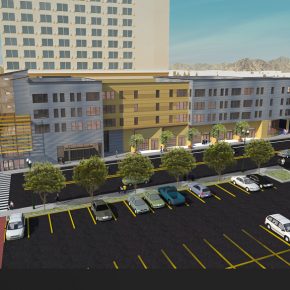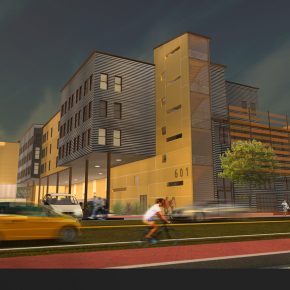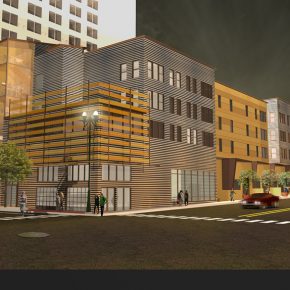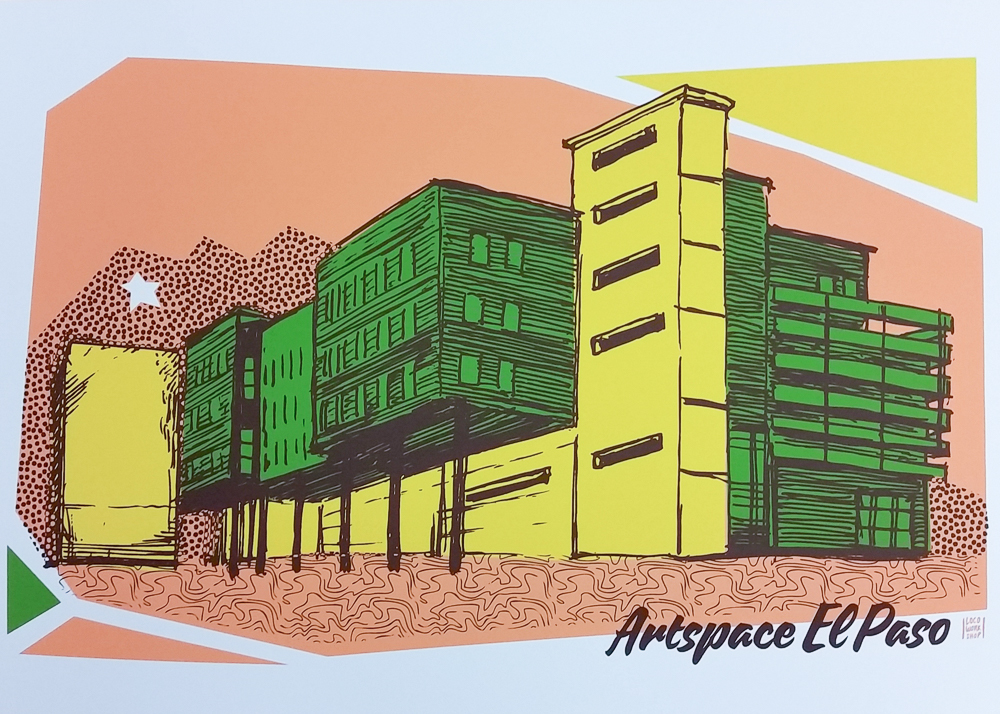
Artspace El Paso Lofts: A Turning Point for the Creative Community
By Miguel Juárez | July 26, 2016
During their visit to El Paso, I scheduled to interview Joe Butler, Asset Manager and Sarah White, Director of Property Development for the Artspace El Paso Lofts, located at 601 N Oregon St, El Paso, TX 79901. She and Joe Butler are part of the team that is coordinating the opening of the new live/work spaces for artists in downtown El Paso that will be opening at the end of this year. Butler and White presented a series of information sessions at various locations in El Paso on July 20-21, 2016. According to Kerry Doyle, Director of the Stanlee and Gerald Rubin Center at UT El Paso: “The project has real potential for being a catalyst for all kinds of artistic possibilities in El Paso, and it is imperative that there be a diverse and representational group of artists participate in the application process.”
Katherine Brennand, a longtime advocate for the arts, said the idea for artist spaces in Downtown El Paso was one of the recommendations of the El Paso Cultural Planning Council (CPC) Project report in the late 1980s. Brennand and BJ Meyers created and ran the CPC in support of area arts groups and projects from the late 1980s to the early 1990s. They created the Bridge Center for Contemporary Arts, among other efforts. According to Brennand, “Downtown El Paso doesn’t have the infrastructure for residential community and without that downtown can ever be the best it can be—this project is really the tipping point of downtown residential life and it will act as a great catalyst for it.”
“The reason that Artspace is so important is because it will bring a group of artists together to inspire each other, and in turn, they will inspire the community.”
– Katherine Brennand, Artspace Advocate
Unforeseen circumstances prevented Joe Butler from joining us for the interview. I interviewed Sarah White on July 20, 2016.
Miguel Juárez: Thank you Sarah for agreeing to do this interview. Aside from my questions that I will ask at the end, I asked five artists and writers who organize local projects in El Paso to send me two to three questions they had about the project and/or the application process. Before we start, can you tell me a little bit about yourself and how long have you been with Artspace?
Sarah White: My name is Sarah White and I am Property Director at Artspace, and I’ve been with Artspace now for three-and-a-half years. I have spent pretty much my entire career in affordable housing development, and before joining Artspace I worked out in Los Angeles and did affordable housing throughout the County of LA. Artspace is headquartered in Minneapolis. It’s a 35-year-old non-profit organization that is committed to creating, preserving and fostering affordable spaces for artists and arts organizations. Initially, Artspace started as an advocacy group and clearinghouse for Minneapolis artists that were getting displaced from gentrifying neighborhoods, and we helped them to find affordable art spaces.
A good example of our early work is in Minneapolis, within out warehouse district; decades ago when things started going south manufacturing-wise, these buildings were left vacant and abandoned. The artist community said, “What a great opportunity, look at these high ceilings, large windows, the expansive, open space is perfect for the creative process”. So they came into these vacant buildings and brought vitality and activity, creating a sense of place and making the neighborhood cool. Then the prices went up and they get shoved out. In our early work, Artspace was established to advocate for artists and to help these displaced artists find new space. Over time what we saw was this deep, deep need for creation of permanently affordable spaces for artists and arts organizations. In the late 1980’s the housing tax program was started and that seemed like a perfect launching point for Artspace to make that leap from advocate to developer. We did our first affordable artists housing projects in downtown St. Paul. The first project was completed in 1990 in the Lower Town neighborhood of St. Paul. Over time, we have grown into a national developer and currently we have about 1,600 artist live/work spaces in our portfolio and about 39 projects in 17 different states, and El Paso is our third project in Texas.
Miguel: Where else in Texas do you have projects?
Sarah: We have projects in Galveston and one in Houston.
Miguel: Thank you. Okay, the first set of questions is from Marcos Rey, https://m.facebook.com/Marcosreyart/. Marcos is the Last Thursdays El Paso Art walk organizer and Downtown History Educator & Promoter as well as an Art Gallery Curator/Organizer and his questions are will they be able to use Artspace as a venue for the Last Thursdays El Paso Art Walk, https://m.facebook.com/LastThursdaysEP/? And his second question is how will they be able to communicate with the artists from Artspace so they can included in exhibits and /or events?
Sarah: Those are great questions. We hope that the building will come alive in Last Thursdays, whether the whole building opens up or just the ground floor commercial tenants and the ground floor gallery space—that depends on the artists that live there. I absolutely see the ground floor gallery in our building as being a happy participant in the Last Thursdays. I could also see some of the artists who live there may want to open up their homes and doing an art crawl for the whole building. Of course that depends on the artists the live there, the artists that move in. In terms of how they would communicate? In operations we have resident committees so there is an exhibits committee. We also have onsite property management so one way to communicate would be through the exhibits committee with some of the leaders that are programming the building and the gallery space. Another option is to send a note to the management company and they can share that building-wide with the all the tenants.
Miguel: Great. The second set of questions comes from Leticia Luevanos, www.leticialuevanos.com. Leticia is visual artist who uses various mediums to express her creativity. Her artwork varies from social injustice installations to expressionist paintings and ceramic reliefs. She received her MFA from Rutgers and is currently a high school art teacher. She uses her art as a means of communication and transcendence of our daily lives. Her first question is how can the Artspace influence art culture in El Paso and specifically downtown?
Sarah: That’s another great question. I think Artspace can help influence the arts scene in El Paso through its gallery space. The gallery is really a fabulous tool for artists in El Paso who live in the building or artists in El Paso who want to collaborate with Artspace El Paso Lofts. The gallery is really a wonderful tool to program exhibitions and events. The gallery can be used to communicate the culture of the art scene in El Paso, through programming, through sharing what is happening in the community and in the building, be it visually or through performances or other mediums. I think too, our commercial tenants will make a positive impact on the culture of El Paso and downtown in particular. I would like to point out that the gallery is free community space for our residents to program, providing them opportunity to curate and showcase local talent. It could be a launching board or springboard for a lot of artists to get their work out there and to share their stories.
The other exciting possibilities are through our commercial tenants. We have a lot of great commercial tenants that are interested and they are all going to be creative businesses; so that is another way that the community can be supported. The local businesses that are going to go into our commercial spaces will all be supportive of local artists, creating opportunities to collaborate, seeing the local arts scene grow and flourish and evolve.
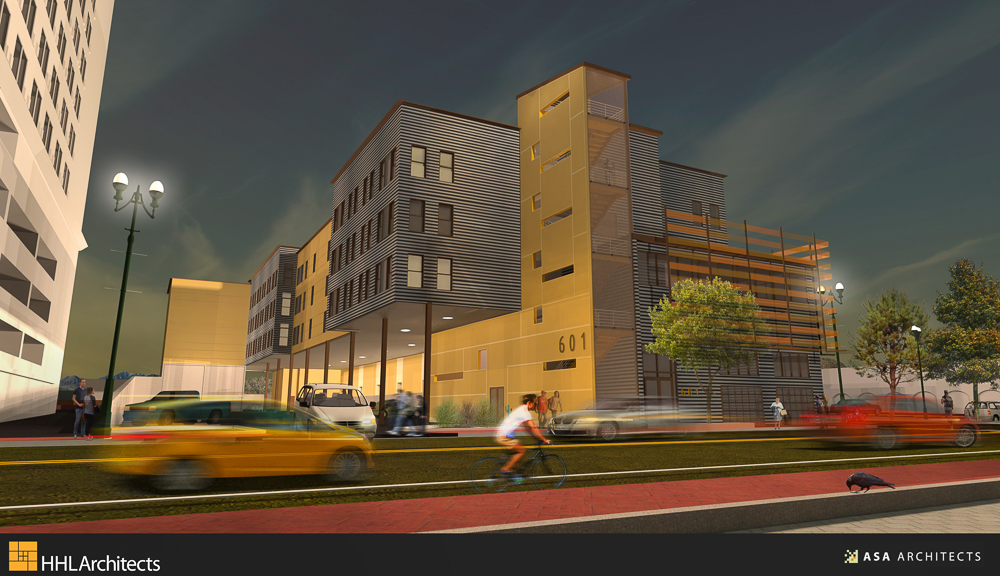
Miguel: Leticia’s next question is how will Artspace involve the community so that there is more engagement that ultimately brings appreciation for the arts?
Sarah: We are currently in the pre-leasing phase and actively looking for opportunities to engage with local artists. Joe Butler, who you have been talking with, is the asset manager and when the project is finished, I transition off the project and Joe becomes the main point of contact for Artspace during the operational phase of the project. Joe is really focused on engagement, he does wonderful work in community organizing. As residents move in, he is going to encourage the development of a resident exhibitions committee, so that the exhibitions committee is empowered to program that gallery space, providing opportunity for collaboration for all the artists who are interested in participating in Artspace El Paso. So through that gallery space there is really an opportunity to engage the community during operations. During this pre-leasing phase, we are really trying to connect with as many people as possible in El Paso, so when we get to the application process we have a diverse a group of artists who are interested in living in the building. Our goal in terms of engaging the community is to make sure that as many different artists from different backgrounds and artistic disciplines are aware of the opportunity to come live at Artspace El Paso Lofts and that they are ready to submit an application on September 1st. My hope for the operational phase of the project is that the artists use that gallery as a real community engagement tool to bring people in and support the art scene here in El Paso.
Miguel: Great. The third set of questions comes from Federico Villalba, fv-foto.com. Federico an El Paso photographer who specializes in Street Photography of la Frontera. Federico’s first question is will there be art exhibition space and you have already answered that, and if so, will this space be open for exhibitions for non-residents of the Artspace community?
Sarah: Yes, that can absolutely happen and again the residents that move in to the building can participate in the exhibitions committee. Typically what I have seen at other Artspace projects is a process or a policy around requesting the gallery for an event, so you might reach out to the manager and state “I have this idea for a show, can I have the gallery from x date to x date and then the manager would send him a form, he would fill it out with details…
Miguel: So, it can be someone from the community and they don’t have to live there?
Sarah: Yes, absolutely. There will be a process around requesting use of the space; our resident exhibitions committee plans the monthly calendar of events and if the gallery is open during those dates, our residents will coordinate event ideas with interested groups. Or there can be some negotiation on dates, etc. There will be a process for people that don’t live there to request to use the gallery and we are certainly open to that type of collaboration. This planning would happen through the exhibitions committee because all our buildings are really resident-driven and resident-programmed.
Miguel: Okay, thank you. Federico’s next question is will there be art programing such as arts workshops for community artists?
Sarah: Artspace does not do programming, we provide the space; however, it would be wonderful if someone from the community can provide workshops and use our space to do that. I think those kinds of collaborations work really well in our building and we welcome that, but Artspace itself is not a programmatic partner. We are just simply the real estate partner and long terms owner that develops these spaces.
Miguel: The fourth set of questions comes from Donna Snyder. Donna has had three books of poetry published by independent small presses. She founded the TumbleWords Project in 1995 https://sites.google.com/site/tumblewordswritingproject/home and continues to organize its free weekly workshops and occasional performance events. Her first question is how can writers make use of the space?
Sarah: Oh, that’s a great question. I mean, I could see a writer’s group coming together using our second floor lounge for a writing workshop or an editing group. The gallery could also be used for that purpose. I could see spoken word happening in the gallery. The units in of themselves, the housing units are nice and open, have high ceilings and natural light. I think it is a really great environment that is conducive to the creative process not just for visual artists but also those writing. I think there are lots of possibilities.
Miguel: So writers can also apply, right?
Sarah: Oh, absolutely. We want as broad a set of creative disciplines at the building as possible. Writers, poets, musicians, craft-makers, culture bearers, native arts, painters, culinary artists, and you don’t need to make your income exclusively from your art either. I think that’s an important thing to make note of. You don’t have to be a professional artist to live there. It can be a vocation or passion that you pursue in your free time, so I think that’s another important point to make the community to be aware of.
We want as broad a set of creative disciplines at the building as possible. Writers, poets, musicians, craft-makers, culture bearers, native arts, painters, culinary artists, and you don’t need to make your income exclusively from your art either.
– Sarah White, Artspace
Miguel: That’s good. Another one of Donna’s questions is how can those who have their own residence use the space? Again, I think she means how can those who don’t live there use the space which is a question a lot of artists are asking—or how will they be able to collaborate with the artists there?
Sarah: One of our commercial tenants is going to be Fab-Lab El Paso, http://fablabelpaso.org/. They are a non-profit organization that is committed to bringing new technologies to the masses, technologies that sometimes can seem intimidating but often with the right instruction are accessible. They are doing really great work out of their current location, helping people make furniture, jewelry, learn how to use laser cutting, 3-D printing. So that’s one-way artists can collaborate, through membership in Fab-Lab. A second way is through the gallery. Collaborating with the artists who live there to plan exhibitions, events, educational workshops. Thirdly, I know there are a number of proposals for the commercial spaces. I’m getting a lot of interest to provide gallery and retail spaces that area all going to be very supportive of emerging talent and local artists. There is certainly the opportunity, I think, in connecting with the commercial tenants to find ways to sell and show work in these potential retail spaces as well.
Miguel: In her third question, Donna asks what is application process? As a follow-up to her question I know that you can point people to URLs but are there people that can talk to potential applicants about what is involved, maybe about discuss issues they may have, etc. Are there people they can talk to? Is there a number people can call?
Sarah: Yes, we are in the process of getting a local number set up and people can e-mail Joe Butler, his e-mail is [email protected] You can also email the property manager, Ish Shah Alarcon at [email protected] On August 15th we are going to release the application. The application process includes a basic rental application and an income certification process. We have already sent around the list of required documents that is part of the income certification process, so people can start working on collecting pay stubs and other documents that are part of the income verification process. We will start accepting applications on September 1st. Between August 15th and September 1st there will be a series of meetings that will provide application support, so if people feel kind of stuck like “I don’t know how to get this document or I don’t have an ID right now, I need to go get one,” the property management company will be on hand at these support workshops to provide guidance, so that people will be ready on September 1st to submit the application.
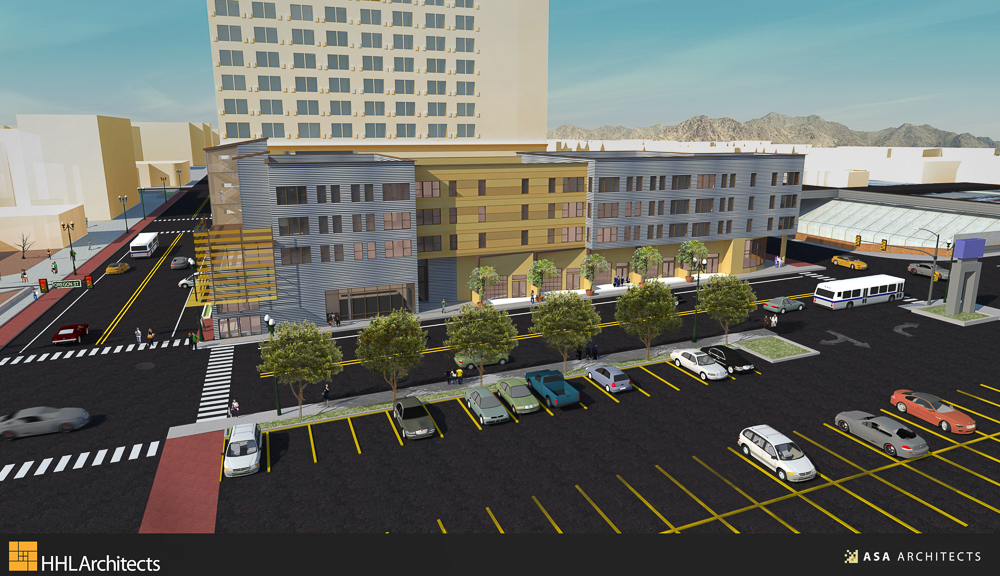
Miguel: Okay, thank you. The last set of artist questions comes from Aaron Torres. Aaron is the creator of the sustainable clothing brand Sleep, Never, http://www.sleepneverlife.com/ and/or https://www.facebook.com/sleepneverlife
He studied digital filmmaking at the Art Institutes. He is currently a member of the band We Wander, the organizer of GANG BANG, https://www.facebook.com/gangbangept/ and curates the blog SLUTSHAME, http://slutshamexxx.tumblr.com/. Aaron states that he has personally been following the ArtSpace project for some time now, and the hopes of living there is part of why he decided to move back to El Paso. He asks if ArtSpace El Paso will be solely rented to El Paso residents, or if you accept potential residents from other cities or abroad?
Sarah: The abroad question is a good question. That would be a follow-up question for the property management company.
Miguel: Like someone from Mexico? Can someone from Mexico apply?
Sarah: My understanding is that an applicant would need to have a work visa to apply, but that is a good question to pose to the management company.
Miguel: Especially given our proximity with Mexico.
Sarah: Absolutely. What is the other part of his question?
Miguel: If you would accept residents from other cities?
Sarah: Yes, we would.
Miguel: Aaron’s second question is “it seems like ArtSpace is essentially Section 8 housing deemed for artists, is that accurate?”
Sarah: It’s actually not accurate, Section 8 is funded through HUD and it is designed as a rental subsidy. The Section 8 program has been an amazing program to house veterans that are experiencing homelessness and other people that are living below the poverty level, including the elderly on extremely limited incomes. In Section 8, people only pay 30% of their income towards rent. The Section 8 program covers the remaining part of the rent. So that’s rental subsidy and that’s a totally different program. I have a lot of respect for the good work that the Section 8 program does to provide housing for underserved communities. A lot of people tend to view it with a negative stigma, which is unfortunate.
But our project is funded through the housing tax credit program, and everyone in the building has to pay rent. There’s no rent subsidy, so people with no income would not be able to afford the rent, because you have to demonstrate that you make at least twice the rent to move in. The housing tax credits are the main way we are financing the project, and they provide about 65% of the funds necessary to construct our project. We were very lucky that we received an award of housing credits from the Texas Department of Housing and Community Affairs. We’ve taken those tax credits and sold them to an investor, who will use them to reduce their tax liability over a ten year period. The equity we receive from our investor allows us to build Artspace El Paso Lofts. In exchange for the housing tax credit equity, Artspace must ensure that we are leasing the housing to households that are earning incomes at or below 60% AMI.
El Paso, for example has an area medium income of about $45,000 for a family of 4. Anyone living in the building needs to have on income at 60 percent of area medium income (AMI) or below. For instance, a one-person household at 60% AMI is earning about $22,000 a year or less, and the rents are designed be affordable for people at these income levels, i.e. 30% of their monthly income. A household is considered rent overburdened when they are paying more than 30 percent of their income towards rent or housing expenses. Theoretically, rents set at 30% of income leave enough money in the household budget for food, healthcare, clothing, other essentials, and savings, so it’s really a great program that is designed to make sure that housing can be affordable for people that are earning incomes at 60 percent of the AMI or below. The housing credit program really has done great job of providing affordable housing for people who are working- a lot of service sector workers are qualified for tax credit housing- cashiers, waiters, chefs, retail employees, food services employees, etc. It’s a great public policy program that makes sure housing can be affordable for lower income, working households.
Miguel: Let me get to Aaron’s other question. He asks, are there going to be any intentions for the ArtSpace team to further branch out to other economically challenged communities that might benefit from such an amazing opportunity, for example, housing strictly for at-risk youth, the disabled, and other specific groups facing adversity? He may be asking if the Artspace becomes very successful, would you consider a second building?
Sarah: I think the market in El Paso is certainly large enough for a second Artspace. The El Paso Community Foundation was a key partner that made Artspace El Paso Lofts possible. It just depends on if there are enough resources to make a second project happen. In terms of our mission, our mission is always to provide housing with a preference for artists, so disabled artists are absolutely encouraged. Actually, anyone can apply. Even non-artists can apply, but there is a preference for artists. For every unit that we have available, if an artist and a non-artist apply, the preference goes to the applying artist over the non-artist. If there is at-risk youth, of course they can apply, but if there is an artist and a non-artist applying for the same units, it would go to the artist.
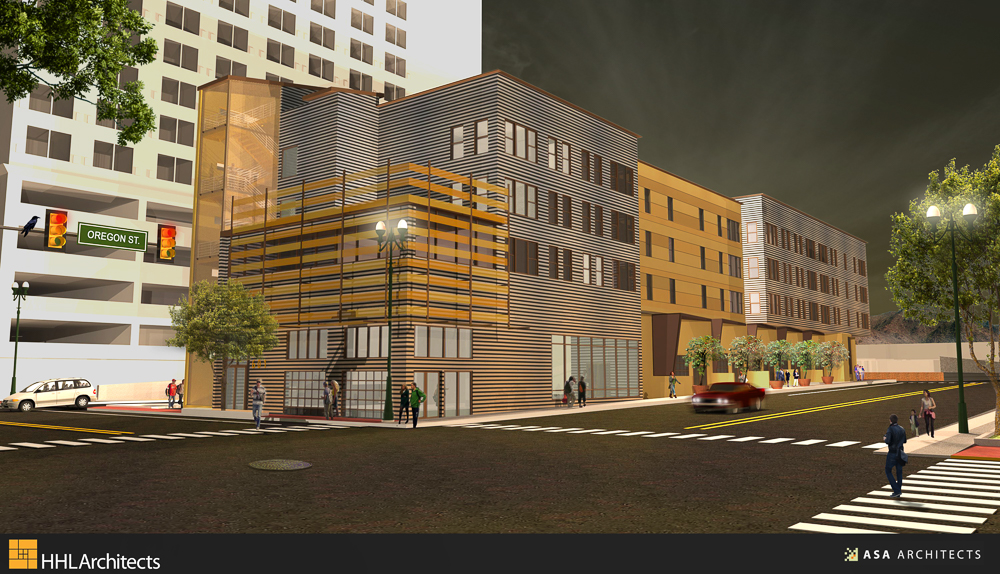
Miguel: Can two people live in a one-bedroom unit?
Sarah: Yes, we have one bedroom, two bedrooms and three bedrooms. And the one-bedrooms are approximately 800 square feet. The two bedrooms are approximately 1,100 square feet and the three bedrooms are approximately 1,700 square feet. The units are designed to have that extra space so you can have maximum flexibility and include in-home studio space within your unit.
Miguel: What if someone rents the first year and then the second year they do not make the required income level? Is there a month-to-month lease?
Sarah: Yes, everyone has to sign a one-year lease. We don’t do month-to-month leases, so each year a new lease will need to be signed. Your income could go up or down after you are initially income qualified. You just have to be income qualified at the time you move in and continue to pay your rent on time. If you can’t pay the rent you have to go. If someone is experiencing financial issues hopefully there are other social supports out in the community that can help them stay housed. But for us to be responsible owners of the property, we have to be able to pay our bills and fix issues as they come up, and to be able to do that, we have to be able to collect rent every month, so it is sort of a social contract there that our tenants have to be able to maintain.
Miguel: Okay, now I can ask my questions. You have answered some of these but I am going to ask them again, some people may need to hear the answers again. I want to preface my next questions by stating that I looked at artist biographies from other locations. One in particular struck me—in New York there was one person who was a hair stylist by day and according to her biography, all aspects of her life were considered art and she is a tenant. In other words could a hair stylist who creates art rent a unit? Likewise, could a biochemistry student who writes about art be a tenant at Artspace? In other words, how are you defining artists for the selection of residents?
Sarah: Yes, that’s a great question and it is so broadly defined. Both of those are great examples of people who would be welcomed at Artspace. And the other thing too, is having been in this job for three-and-half-years, I notice how insecure artists are about whether or not we will consider them an artist. I hear a lot of… “Oh, I was going to apply but you would never take me.” I always say, “no, that’s absolutely not true; believe in yourself. If you are a creative person, we are going to think that you are a creative person. Don’t count yourself out”, that’s my message for this interview. We want our buildings to be welcoming and inclusive of many different disciplines and creative pursuits and again, I just want to stress you don’t have to make your income from your art. You don’t have to be a full-time professional artist. It’s a place where lots of people from different backgrounds and artistic disciplines come together and those synergies and that diversity helps everyone grow and expands their creativity and their ability to collaborate. On our website we have a lot of great resources. There’s a video…you go into our website and in our search box under “Why Artspace Matters” (http://www.artspace.org/ideas-insights/artspace-videos) there’s a little video on there, it’s about five-to-six minutes and it’s Artspace from the perspective of residents. It gives you a sense of how artists living in some of our other properties feel about the environment and the experience. People can check that out too.
If you are a creative person, we are going to think that you are a creative person. Don’t count yourself out, that’s my message for this interview. We want our buildings to be welcoming and inclusive of many different disciplines and creative pursuits and again, I just want to stress you don’t have to make your income from your art. You don’t have to be a full-time professional artist.
– Sarah White, Artspace
Miguel: Okay. You already answered my next question but not the second part of it. How did you determine the rental prices for El Paso, for example, did you study the apartment market study? How do the Artspace rental prices compare to other similar-sized cities?
Sarah: Yes, rental prices are set by the federal government, and that is part of the housing tax credit program. El Paso has a fairly low area medium income and that is why the maximum income for the 60 percent AMI units is fairly low. New York City has a higher area medium income so the maximum qualifying income is higher and the rents are higher. Same with our project in Santa Cruz, California, relative to the high area medium income, maximum rents and incomes are a little bit higher. All the rents and income limits at all of our properties are based on the community’s area medium income so they range pretty widely across the country. As far as how they compare to similar-sized cities, again that would compare to variables, for example in Silicon Valley the medium family income is $100,000 and rents would be a lot higher, so it just varies from community to community.
Miguel: Is there a deposit?
Sarah: There is a deposit. I don’t think we have set that yet, but there is typically a deposit.
Miguel: How did you arrive at the salary range that renters must have to be considered to lease an apartment and how stringent is the credit check?
Sarah: Incomes, again, are set by the government. The credit check is mainly to know if you had an eviction and if so, was it recent and documenting if you have problems paying the rent. That is the main reason for the credit check.
Miguel: Does the applicant pay for that credit check?
Sarah: I do believe that there is a credit check fee.
Miguel: Echoing Aaron’s question, will there by any assistive apartments for artists with disabilities? And you already said yes.
Sarah: Yes, we have units that are fully adaptable.
Miguel: The following question was asked at one of the public forums—what if an artist has a prior arrest record? Can they rent an apartment?
Sarah: That depends on a couple things. One is timing- was it a long time ago or recent? Another one is that if it is a misdemeanor or a felony? Is it a violent crime or is it a non-violent crime? We have to lease apartments according to state and federal regulations, so I would defer to the property management company to find out more. If an application is denied based on some sort of criminal background, an applicant could appeal it if they feel that there are circumstances or mistakes in the report that are worth an appeal, we would certainly encourage doing that.
Miguel: Okay. Related to the previous question, how will Artspace make sure common spaces and the building itself stays safe? Will there be a residents’ council who will set rules, etc. and make sure residents abide by them? What if a resident is not abiding by the rules? Who will decide to end their lease?
Sarah: As part of a lease there are house rules and there are community hours for the gallery. The gallery will be open for residents during community hours and open to the public for events, and it will be secured so that only a resident with a card can get into the gallery unless there is an event happening and it is open to the public. We don’t have a lot of problems with theft within the building because it is a pretty cohesive community that is working together and they are all artists and they all respectful of one another’s work. If there was an artist-resident who was not following the rules they would get a written up. After three write-ups, then it’s eviction. So that’s the process. Usually, people do not want an eviction on their record. They will leave before it gets to that point.
Miguel: Related to that issue, based on issues that have surfaced at other locations, what potential residents don’t you want to apply at Artspace? That may be a difficult question to answer?
Sarah: If you are talking about someone who is going to come and be super- disrespectful typically those people will be weeded out through the application process. Either they would not pass the credit check or they would not pass the background check. I would just say that through good property management you can keep people respectful—the underlying theme of the building is one of respect and collaboration. Those are the types of people who tend to live in Artspace. The average residency is seven years. People move in, make great friends and really enjoy it. I hope this is what we will see here happening in El Paso. The quality of the artists here is really phenomenal, all these questions are off the charts amazing, thoughtful and really intelligent questions. I expect we will get a lot of that curiosity, talent, commitment and creativity in our building.
Miguel: My next question is how will the businesses be selected?
Sarah: We probably have most of the businesses selected at this point. That’s a different process because it is not income restricted. We are really more interested in determining the mix of businesses that will be the right fit for the community. Who’s more prepared to run a business? I’ve just been encouraging people to send me a write up and a budget demonstrating how their business would cash flow. We’re in the process of sorting all that stuff out right now.
Miguel: Are you going to have a waiting list of businesses that may want a space later if another one doesn’t work out?
Sarah: That’s a good question. I haven’t gotten that far yet. I could see about maintaining a waiting list for that though.
Miguel: Is there an age limit?
Sarah: For the apartment, if you are going to hold a lease, you need to be an emancipated youth or 18 years of age.
Miguel: Could someone be in the 80’s and rent a unit?
Sarah: Absolutely, we encourage people of all ethnicities, all genders, all ages to apply, all artistic backgrounds, absolutely.
Miguel: Several people have asked about parking—will there be parking or how will parking be handled?
Sarah: Yes, we have 31 parking spots and in addition to that Downtown El Paso has a meter program for residents. It seemed pretty affordable. It allows residents to park downtown at any meter, without having to pay the meter. There are also street parking options.
Miguel: How will tenants be selected?
Sarah: On August 15th we will release the application and that gives potential tenants two weeks to fill out the application, come to application assistance workshop, get all their income certification documents together and submit the application on September 1st. I would really encourage people to apply on September 1st because applications will be processed on a first-come, first-served basis, so I think fifty-one units in the city of this size will go pretty fast especially because El Paso is really an arts town. I think they will go fast, so I really, really, want to get the word out. You don’t have to be a professional artist. You don’t have to make your income from your art. If you consider yourself an artist; we probably will too. We are not going to judge the quality of your work. It is not a juried process to get in, so please be ready to submit your application on September 1.
Miguel: How are you going to get away from people thinking “so and so got in because so and so is this.” Or “so and so got in because so and so knows this person.” How are you going to get away from the perception of favoritism in the selection of artists? We can say that it won’t happen, and that it’s not going to happen, but…
Sarah: I hope people won’t think that, we try hard to make the process pretty transparent. We are making the application available August 15th. Joe and I have been having a series of meetings to try to reach out to as broad of a swath of El Paso as we can and make sure that all kind of different artists and all parts of El Paso are aware of opportunity with the goal of being as inclusive and communicative as possible about this opportunity. The applications again, are available August 15th there are some application workshops that are happening between the 15th and the 1st. Applications can be submitted on September 1. Applications are processed in the order that they are received, so those applications submitted on September 1st will be the first ones processed, so it doesn’t get more transparent than that. No playing favorites, no bumping someone up. I really recommend people apply on the 1st!
Miguel: How did the local information sessions go? Were they well attended? And what kinds of questions did you get?
Sarah: Let’s see, we had our first info session in July at the El Paso Community Foundation and about 90 people came and lots of really great questions similar to this these that were asked. And then we had another one at Sacred Heart Church thanks to Father Ron, and tonight we will be at Proper Print Shop from 6 to 9 p.m. And mid-August, right around the application release we will have another series of events and so hopefully by this point a lot people are aware. We have also been having one-on-one meetings with people asking them to help spread the word. A great way to keep in touch with us over summer is to go to our website which is www.artspace.org/elpaso We have a lot of great information, like all the amenities, the floor plans, rental income limits. We also have the option to sign up from our website, to sign up for our Constant Contact e-mail list. Go to www.artspace.org/elpaso, scroll down a little bit and you will find “Property Updates,” then you click on that and that’s how you sign up for the El Paso Interest List and from there we will send updates with new meetings when they come online. We are really trying to communicate with our followers through the constant contact list and through Facebook. You can also find us on Facebook and “Like” us there as well.
Miguel: Okay, that’s it, thank you.
Sarah: This was such a great interview. Thank you!
Photographs by Artspace.
Author’s Comment: According to the Artspace.org website Joe Butler, the Project Manager for Artspace El Paso Lofts has experience in community organizing, public housing advocacy, and community re-development strategies in New Orleans, Detroit, Atlanta, and Camden (1991-98), social redress planning and development in South Africa (1998-2005), and recovery planning and implementation in post-Katrina New Orleans (2006-09). He has 20 years of experience in community planning and development includes community organizing, neighborhood planning, public engagement and grassroots organizational development.
I would like to thank multidisciplinary researcher, thinker, writer and artist Nicolas Silva for recommending several of the artists and writers for this interview.
Miguel Juárez is doctoral candidate (ABD) in history at the University of Texas at El Paso and is the author of Colors on Desert Walls the Murals of El Paso (1997, Texas Western Press) and is co-editor (with Rebecca Hankins, Associate Professor at Texas A&M) of Where Are All the Librarians of Color: the Experiences of People of Color in Academia (2015, Library Juice Press). His research interests include artists and art making, borderlands history, Chicana/o history and culture, libraries and archives and urban history: https://utep.academia.edu/MiguelJuarez
You can follow him @miguelJuárez


